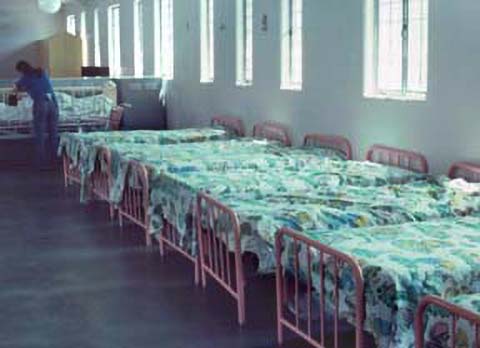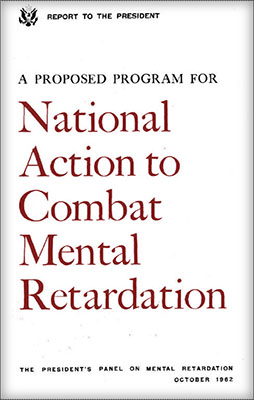The 1960s: Family, Improved Institution, Smaller Institutions or Community Residence
In the 1960s, institutions began to be seen as dehumanizing places of custodial care. In 1962, The President's Panel on Mental Retardation redefined the role of institutions and supported the concept of community residential alternatives.
Exposés on the conditions in institutions raised the consciousness of many professionals and community members. In 1966, Burton Blatt and Fred Kaplan published Christmas in Purgatory. In 1968, NBC10 aired Bill Baldini's exposé on Pennhurst.
The tide began to turn to deinstitutionalization and the development of community alternatives. The direction of change was in two directions – improve the quality of services in institutions and stimulate the development of community alternatives.

Photo courtesy PCMR publication
These two roads, however, were not evenly traveled. By far the majority of resources went to the institutions, not to community alternatives. This two track approach was the dominant strategy for two decades and delayed the development of community alternatives.
Some of the key concepts and strategies of the 1960s had meanings which were quite different than today's. For instance, the major meaning of "community alternatives" in the context of the President's Panel's recommendations was smaller institutions in more urban settings.
The proposed change for institutions was to develop "small, residential units having 500 beds, accessible to or in urban areas, and combined residential and day care units should gradually replace large institutions isolated from the centers of population. Special efforts should be made to return the institution to the community."
Toward the end of the 1960s, three concepts grew in importance.
Continuum of Care – The President's Panel described the continuum as "the selection, blending and use, in proper sequence and relationship, of the medical, educational and social services required by a retarded person to minimize his disability at every point in his lifespan." For the President's Panel, the continuum related largely to age – needs changed with age.
The Principle of Normalization – Numerous publications (for instance, by the International League of Societies for the Mentally Handicapped (ILSMH) and the President's Committee on Mental Retardation (PCMR)), recognized that the Principle of Normalization emerged in the 1960s as the most important concept shaping the future of residential services. At the time, is was defined as "making available to the mentally retarded patterns and conditions of everyday life which are as close as possible to the norms and patterns of the mainstream of society… it essentially refers to approaching the retarded as much as possible as if they were normal." (ILSMH, 1969).
The Developmental Model – In its 1969 statement about residential care, the International League of Societies for the Mentally Handicapped stated that "residential services should be based on a developmental model on mental retardation, fostering optimum humanization of each resident." The core idea was that individuals' needs change over time.

Photo courtesy William Bronston, M.D.
Redefining the Institution
At the time, the major impact of these concepts was to redefine the role of the institution. The institution came to be seen as only one of several resources, and appropriate for only some people.
The conditions in institutions came to be seen as fundamentally dehumanizing. The debate about for whom institutions are appropriate would continue for decades.
There were no expectations and little contract with the outside world for children with developmental disabilities in institutions.

Gunnar Dybwad and Niels Erik Bank-Mikkelsen

Bengt Nirje, Robert Perske, Wolf Wolfensberger, G. Allan Roehrer
Photos courtesy William Bronston, M.D.
The Readiness Model
The debate in the 1960s certainly laid the groundwork for the "get ready" or "readiness model"(also described as the continuum of services, least restrictive environment and the cascade model). There was also a recognition that some individuals could move to the community, some sooner than others, while others would never be ready.
Those who left might move to group living situations, then independent living. The advent of developmental programming in institutions would prepare people for the community. On the other hand, there was an apparent consensus that some would never be ready.
As is often the case, the concepts of continuum and least restrictive environments led to somewhat contradictory outcomes – on the one hand, the development of many more positive alternatives for individuals, and at the same time, limiting choice by preconceived notions of which people qualified for or were ready for those alternatives.

Photo courtesy William Bronston, M.D.
The 1962 language of the Executive Director of the New York State ARC, though harsh to our ears today, captures the essence of this thinking: "If after these were set up [small residential centers in the community for people considered trainable and educable] we had a residue of so-called custodial or medical cases, for whom there is no prognosis for even quasi-independent living, but who will need care all through their lives, perhaps we could borrow a page from Connecticut and other communities where small hospital-life facilities are being created… for this type of care."
ENCOR was the first truly comprehensive community based program in the United States. This program was designed to provide the full range of services – from cradle to grave. ENCOR included some "firsts" and innovative practices.
Some of the key concepts of the President's Panel set the course for developments for decades:
- Institutional care should be restricted to those whose specific needs can be met best by this type of service. Institutions are one facet in a continuum of care.
- No child or adult should remain in residential care any longer than necessary.
- If and when the child or adult is ready for return to the community, adequate resources and services for his support should be made available. It may not be wise or possible for some to return to their own families, hence the importance of developing foster or boarding home placements, or homes for small groups similar to those in several European countries.
- Responsibility for the care of persons returned to the community should not be relinquished by the institution until assistance is assured from some other sources; efforts should be made to see that community services are made available to him before he leaves.
Bringing the provision of services as close as possible to the local community is a basic tenet on which the Panel's recommendations rest.
The idea of "close to the community" was linked to the Scandinavian experience.

Photo courtesy William Bronston, M.D.
Throughout the 1960s, a great deal of attention and praise focused on the Scandinavian approach to residential services.
People were attracted to the fact that residential homes were smaller, located closer to metropolitan areas, generally in residential neighborhoods, and, in the words of Mrs. Hubert H. Humphrey (a member of the President's Committee at the time), "clean, sparkling and beautifully kept." Normalization had been embedded in Swedish law.
A film about the Fairview, Oregon institution.

